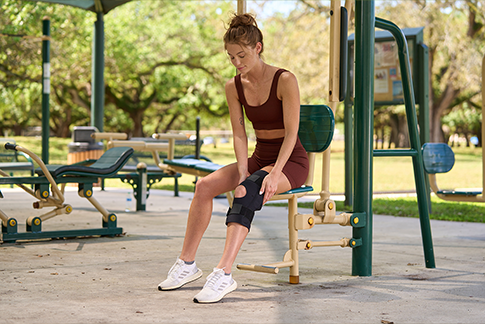How to Choose and Wear a Knee Brace
Overwhelmed by the variety of knee braces that are available? This guide will walk you through the different types of braces you can buy and help you choose the right one for the knee issue you’re experiencing.
Knee Brace Levels of Support
Different knee braces offer varying degrees of support — from soft knee sleeves offering light protection and a full range of motion to rigid, hinged knee braces that provide maximum support and also limit your movements.
When you’re shopping for a knee brace, you should know that there are three levels of support to choose from:
- Light support (level 1 support), such as a compression sleeve, is appropriate for general pain relief. Level 1 knee braces have no rigid parts, enabling the knee to have full range of motion.
- Moderate support (level 2) knee braces are made with some plastic or metal materials, providing more stability and limiting movement. This level of support can help problems such as tendonitis or ligament instability.
- Maximum support (level 3) means a rigid or semi-rigid knee brace that strictly limits the motion of the knee (with hinged braces) and may even immobilize it completely. This level is often part of a post-surgical plan or used for major joint instability.


Knee Brace Functions
Knee braces fall into five categories, each intended for specific purposes and conditions.
Prophylactic knee braces help prevent injury while you’re playing sports or participating in any activity that may strain the knee. These braces are especially helpful for preventing MCL (medial collateral ligament) injuries. They’re not meant to be worn during normal daily activities.
Functional knee braces support knees that have already suffered a past injury, such as a ligament tear. Functional braces stabilize knees and help prevent further injury.
Patellofemoral knee braces are designed to support and align the patella (kneecap), relieving anterior knee pain. These braces are usually soft, with a cutout hole for the kneecap.
Rehabilitative or post-op knee braces help you heal after a knee injury or surgery by limiting movement. Typically prescribed by a healthcare provider, these braces may have adjustable hinges to slowly increase the range of motion as your knee recovers.
Unloader or off-loading knee braces are designed for people with osteoarthritis pain on one side of the knee joint. The off-loading brace shifts pressure from the affected side to the stronger side of the knee joint, relieving pain. This type of brace also can relieve pressure on the medial or lateral meniscus after an injury or surgery.
Types of Knee Braces
The level of support and stabilization a knee brace provides depends on its construction. Knee braces and supports range from simple knee bands and sleeves to rigid hinged braces. Not sure which is the best knee brace for you? Talk to your doctor or orthopedist.
Knee sleeves are a type of compression knee brace. They are easy to pull on and wear beneath your clothes. Knee sleeves redistribute the weight-bearing load and can help arthritic knees and chronic knee pain. Because they allow a free range of motion, they may be the best knee braces for running or exercise.
Patellar braces help align the patella (kneecap) to relieve pressure on the tendon. They’re similar to knee compression sleeves, but with a thicker section that keeps the patella in place.
Wraparound braces wrap around the knee and close with straps. They are easy to put on, but are bulkier than compression sleeves. Wraparound knee braces provide both compression and moderate support, helping to relieve mild to moderate pain. They also provide stability in cases of patellar dislocation or instability.
Hinged knee braces hold the knee in proper alignment, providing medial-lateral support and limiting the amount of movement possible. Hinged braces may be soft or rigid, providing moderate to maximum support. They’re typically recommended after knee surgery or when recovering from a ligament injury.
Knee bands or straps fasten around the calf, directly below the kneecap. Knee bands provide support and pain relief for conditions such as runner’s knee and jumper’s knee by putting pressure on the tendon that holds the kneecap in place.
Knee sleeves, wraparound braces, and hinged braces all may have an open patella — a hole in the center of the brace, over the kneecap — or a closed patella. Open patella braces provide more kneecap support and relieve pressure on the kneecap, while closed patella braces keep the pressure consistent across the whole knee.

Related Products

